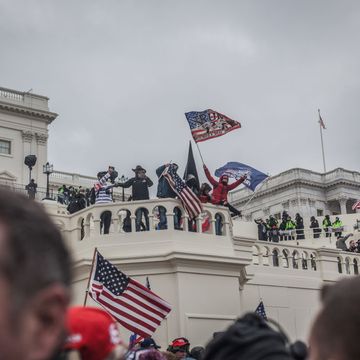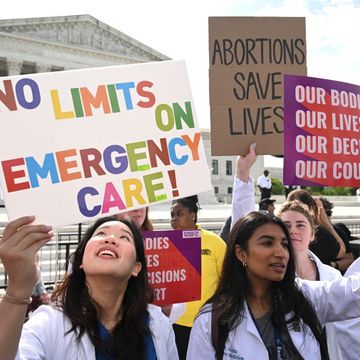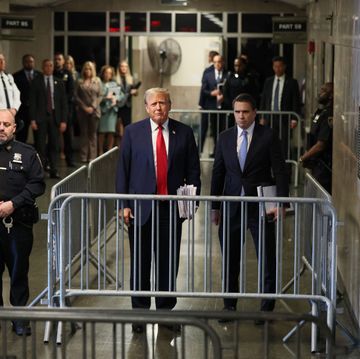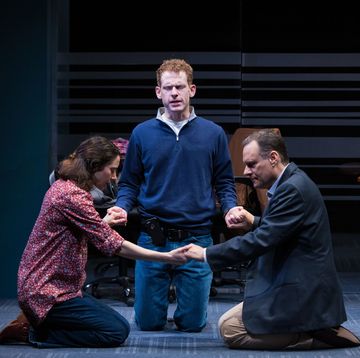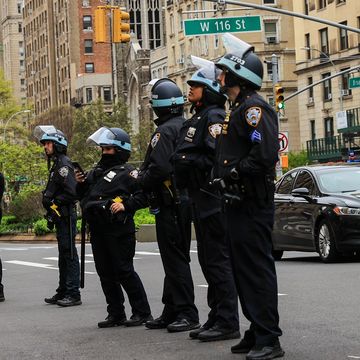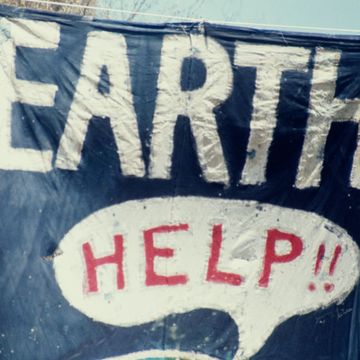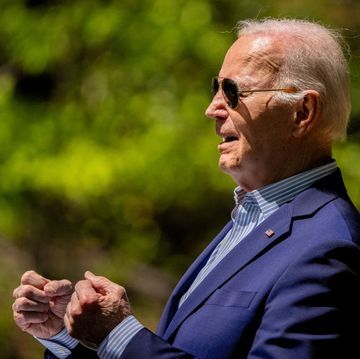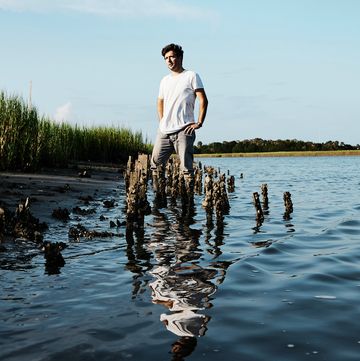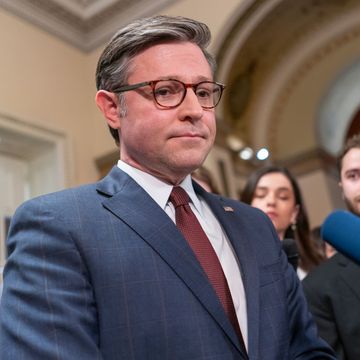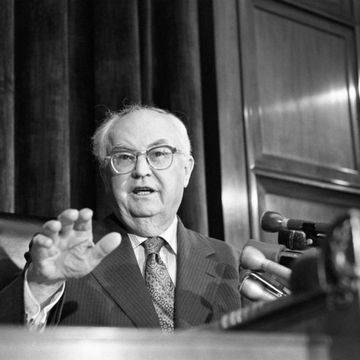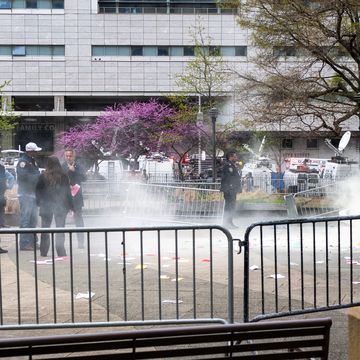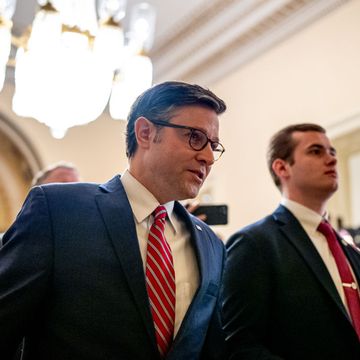The laboratory at night, the lights down low. An iMac streams a Pat Metheny version of an Ennio Morricone tune while Dr. Jacopo Annese, sitting in front of his ventilated biosafety cabinet, a small paintbrush in his hand, teases apart a crumpled slice of brain. The slice floats in saline solution in a shallow black plastic tray, and at first it looks exactly like a piece of ginger at a good sushi restaurant, one where they don't dye the ginger but leave it pale. Then Annese's brush, with its practiced dabs and tugs, gently unfurls it. The slice becomes a curlicued silhouette, recognizable for what it is, what organ it comes from, even if you are not, as Annese is, a neuroanatomist.
He loves quiet nights like these, when his lab assistants set him up with everything he needs — the numbered twist-off specimen containers, the paintbrushes, the empty glass slides — and then leave him alone with his music and his work.
Annese coaxes the slice into position above the glass slide that lies half submerged in the tray, cocking his head, peering at it from different angles, checking to see that he has the orientation right. The left hemisphere must, when you're looking directly at the slide, be on the right side of your field of view, just as it would be were you staring into the eyes of the brain's owner. Although brains are roughly symmetrical, they are not entirely so, and Annese has become familiar with the individual topography of this one, all its subtly asymmetric sulci.
For additional reference, Annese occasionally glances at a digital photograph on the screen of the computer. The photograph, two months old, was taken during another late night at the lab. It shows a bladed machine, a cryomicrotome, similar to a meat slicer in a deli. The machine holds a block of frozen gelatin and the block of frozen gelatin holds a brain. Annese had sheared the whole brain into 2,401 seventy-micron-thin slices, the camera snapping once before each pass of the blade, and this particular image captures the moment before he sheared off the slice that now floats before him. The picture provides a useful comparison for Annese now, showing the slice as it looked in situ.
That night of slicing had not been as solitary as this one. Not only had all his lab assistants been here, but thousands of other people had been present in another sense, since Annese had streamed the event live online. A colleague of Annese's later confessed that he had watched the Web stream with anxiety, hoping that Annese wouldn't become famous as the second doctor to screw up this particular brain.
A few more gentle prods and then Annese begins to slowly pull the glass out of the tray. Before he trained as a scientist, he worked as a cook, and he often uses cooking analogies to explain his work. The art of histology is a lot like baking, he says, since everything from the samples to the temperature to the tools must be finely calibrated, with little room for improvisation. And he is proud, justifiably so, of his skills: Soon the slide, with its burden perfectly positioned, is resting safely on the tepid surface of a warmer, where it will be left to dry overnight.
Annese reaches for another cryogenic vial, number 451, screws off the lid. Just before he tips the next slice into the tray, he smiles and turns to me.
"See," he says, "how much work I have to do to clean up the mess your grandfather made?"
There were things Henry loved to do.
He loved to pet the animals. The Bickford Health Care Center was one of the first "Eden Alternative" elder-care facilities in Connecticut, which means that along with its forty-eight or so patients, the center housed three cats, four or five birds, a bunch of fish, a rabbit, and a dog named Sadie. Henry would spend hours sitting in his wheelchair in the courtyard with the rabbit on his lap and Sadie by his side.
Another thing he loved was to watch the trains go by. His old room, 133, is on the far side of the center, and its window looks out on the tracks, where several times a day the Amtrak roars past. The canal for which the town of Windsor Locks was named runs parallel to and just beyond the tracks, and beyond the canal looms the abandoned redbrick husk of an old paper mill.
He loved word games. Many of the scientific papers that have been written about Henry describe his avidity for crossword puzzles, though in his later years, according to a nurse at the center, Henry found crossword puzzles too great a challenge, and started doing simple find-a-word puzzles instead.
He loved old movies. Bogart and Bacall, that era. The classics, we would call them, though of course they were not really classics to him. He'd ask to see one of these old movies and one of the nurses or attendants would pop in a videocassette and press play on the remote control. Television sets were no shock to him, TV being a technology that developed during his time. But he never figured out how to operate a remote control.
There was one TV series he loved to watch, too. A sitcom. All in the Family. It is a show, essentially, about a man who is mystified by a world and culture and family that change all around him while he remains the same, a man who digs in his heels, who holds on to the past, refusing to be dragged into the present.
Henry was an extremely nice guy. Courteous, cheerful, compliant. He almost always took his meds when the nurses asked him to. On the rare occasions that he was stubborn and refused to take them, the nurses knew of an easy way to get him to cooperate. It was a trick passed down over the decades, from one nurse to another.
Henry, a nurse would say, Dr. Scoville insists that you take your meds right now!
And then, invariably, he would comply.
This strategy worked right through till the end, until Henry died, two years ago. The fact that Dr. William Beecher Scoville had died long before then made no difference. Dr. Scoville remained an undying authority figure in Henry's life because Henry's life never really progressed beyond the day in 1953 when Dr. Scoville, my grandfather, removed some small but important pieces of Henry's brain.
May 25, 1992:
RESEARCHER: How long have you had trouble remembering things?
HENRY: That I don't know myself. I can't tell you because I don't remember.
R: Well, do you think it's days, or weeks, months, years?
H: Well, see, I can't put it exactly on a day, week or month or year basis.
R: But do you think it's been more than a year that you've had this problem?
H: Well, I think it's about that. About a year. Or more. Because I believe I had an ... this is just a thought that I'm having myself, well, I possibly have had an operation or something.
R: Uh-huh. Tell me about that.
H: And uh, I remember, I don't remember just where it was done, in, uh ...
R: Do you remember your doctor's name?
H: No, I don't.
R: Does the name Dr. Scoville sound familiar?
H: Yes! That does.
R: Tell me about Dr. Scoville.
H: Well, he, he would, he did some traveling around. He did, well, medical research on people. All kinds of people. In Europe, too! And the wealthy. And out on the movie stars, too.
R: That's right. Did you ever meet him?
H: Yes, I think I did. Several times... .
R: Was it in the hospital?
H: No, the first time I met him was in his office. Before I went to a hospital. And there, well ... well, what he learned about me helped others, too. And I'm glad about that.
My grandfather's home was full of curious artifacts, each with its own story. He traveled a lot, all over the world, and always came home with something new and strange. It was a lifelong occupation: In the mid-1920s, he'd taken what was in those days a very unusual trip to China and ended up paying some of his college tuition by selling the exotic jewelry he brought back to the States. Many of the items in his home looked like they belonged in a cabinet of curiosities. There was a carved wooden totem hanging on one wall of his dining room, some sort of pagan king or god. It was maybe three feet tall, had a soulful, mournful expression. One Thanksgiving, when I asked where it came from, I was told he'd received it during a trip to South America, perhaps in gratitude for some operation he'd performed there. The carving had apparently once been an object of worship, owing mainly to the fact that it would, at times unpredictable, weep, drops of water streaming from its eyes. Did seasonal moisture variations and the way the wood responded to them cause the tears? Probably. That or magic. My grandfather had appreciated the totem's beauty but was unsentimental about its emotions. When he brought it home, he had someone polish it before he hung it on the wall. It never cried again.
Brain surgery is an ancient craft — there is a four-thousand-year-old hieroglyphic text describing successful operations — and among my grandfather's most interesting artifacts was a collection of premodern and tribal neurosurgical instruments. As a kid, I found those picks and blades fascinating and terrible to contemplate. It wasn't just the age of the tools, it was the acts they were intended for. Brain surgery, whatever the era, always requires at least two frightening qualities in its practitioners: the will to make forcible entry into another man's skull, and the hubris to believe you can fix the problems inside.
He was always a risk taker. During medical school he'd climbed, on a dare, one of the suspension cables of the still-under-construction George Washington Bridge and spent the night shivering in a crate up top, waiting for the dawn. Once, while attending a neurosurgical conference in Spain, he visited a small bullring where toreadors were practicing their craft, threw off his jacket, and stepped into the ring himself. He loved cars, loved driving them as fast as they'd go. He loved tinkering with them, too. He always told people he'd have been a mechanic if he hadn't become a brain surgeon.
In 1939, a year after he completed a residency at Mass General, he cofounded the Department of Neurosurgery at Hartford Hospital. It was an interesting time for an ambitious young doctor to be entering his particular field, since a new kind of brain operation was on the verge of becoming a worldwide sensation. The operation had originated in Europe and was pioneered by Egas Muniz, a Portuguese surgeon, who would go on to win a Nobel prize for his efforts. Dr. Muniz called his operation leukotomy, but in the United States it came to be known by another name: lobotomy. The operation was crude — the surgeon would drive a skinny ice pick up through the thin bone behind his patient's eyeballs, then quickly swish the pick back and forth, cutting a messy swath through the frontal lobes — but it was inarguably effective at transforming otherwise difficult and uncontrollable individuals into placid, carefree creatures.
My grandfather had no problem with the basic idea of treating psychiatric problems through brain surgery. He believed that psychosurgical procedures might eventually, as he once wrote, relegate "psychoanalysis to that scientific limbo where perhaps it belongs." But he didn't like the lobotomy. It was too blunt, too imprecise, knocked everything out, the good with the bad. It makes people "easy to control and easy to handle," he said, "but, God forbid, at what a cost!" There had to be a better way. Some way to achieve the lobotomy's beneficial effects — the calming, the reduction in anxiety — without the lobotomy's attendant insidious, zombielike stupor.
So he tinkered. He began experimenting, at asylums in and around Hartford, with procedures he called "fractional lobotomies," attempting to target only the specific brain structures he believed were implicated in a particular patient's problems. Soon he was reporting a "most gratifying improvement in depressions, psycho-neuroses and tension states without any gross blunting of personality." And he mused about possible future advances and refinements to his approach, wondering whether his experiments in targeted brain lesioning might "bring us one blind step nearer" to the locations of the "fundamental mechanisms of mental disease and of epilepsy."
Around this time, Henry showed up in his office for a consultation.
When Henry Molaison is seven, a bicyclist collides with him, knocking him out cold for five minutes, leaving him with a deep gash in the left side of his forehead.
After that, the seizures begin.
They are minor at first, but gradually increase in severity. At the age of sixteen, he experiences the first seizure of the type that used to be called grand mal and is now called tonic-clonic. He attends Windham High School in Willimantic, Connecticut, is smart, sharper than most. But the other students — watching him seize up ten or more times a day — tease him without mercy. Henry drops out of high school for a while but eventually goes back, struggles his way through to a diploma.
The seizures keep getting worse. He is in his early twenties, foggy-headed, living at home with his parents, no social life, barely holding down a job as a motor winder, when he has his first appointment with my grandfather.
My grandfather prescribes him Dilantin, phenobarbital, Tridione, Mesantoin, the best anticonvulsants of the day, in maximal doses. They don't work.
Henry's epilepsy is severe, horrible, intractable.
My grandfather suggests they try something else. Henry and his parents agree.
They are willing to try anything.
August 25, 1953. Henry lies on his back on an operating table in the Hartford Hospital neurosurgery suite. At the head of the table, flanked by scrub nurses and assistants, my grandfather leans over Henry with a trepan in his hand. Henry has been sedated and given a local anesthetic, and the flesh has been peeled down from his forehead, but he is conscious. A trepan is a sort of wide-mouthed serrated drill. The particular trepan he's using, like a lot of his surgical instruments, and like the operation itself, is of his own invention. To make this trepan, he bought a hole saw from a local auto-supply or machine shop for about a dollar, then attached it to a standard Hudson drill handle, the kind you crank by hand. Now he places the trepan down onto Henry's exposed skull, just above one of his eye sockets, and bears down. It grinds through, extracting a button of bone roughly the size of a poker chip. He moves the trepan over a few inches, to the same spot above the other eye socket, and repeats the process. Scrub nurses flush the holes, exposing Henry's pale frontal lobes to the harsh light of my grandfather's headlamp. He puts the trepan aside, picks up a slightly curved metal retractor, inserts it into one of the holes, then levers Henry's frontal lobe up and out of the way, so he can reach the hidden structures deeper in the recesses of Henry's brain.
Once he finds what he's looking for, the sea-horse-shaped hippocampus and its adjacent organs — the hook-shaped uncus, the almond-shaped amygdala — he proceeds with the extraction. He's performed variations of this operation on a number of asylum residents but never on an epileptic. Still, he knows that the hippocampus — an organ whose precise function is a mystery to him, as it is to everyone else in 1953 — has been implicated in some forms of epilepsy, and that other surgeons have had success reducing seizures by removing one half of it, performing a so-called unilateral resection. With Henry, however, he decides to see what happens if he takes out both sides, not just one. He uses an electric cautery to cut the tissue and a skinny vacuum to suck it out, leaving behind just a negligible stump. Then he repeats the procedure on the other side. In all, taking both hemispheres into account, he removes several tablespoons of neuronal tissue.
Before he plugs the holes, he uses another tool to snap a few tiny metal clips onto the frayed far frontier of the fresh lesion. The operation is, as he will later write, a "frankly experimental" one, and these clips, visible in X-rays, will help him document its parameters.
RESEARCHER: Do you know what you did yesterday?
HENRY: No, I don't.
R: How about this morning?
H: I don't even remember that.
R: Could you tell me what you had for lunch today?
H: I don't know, to tell you the truth.
April 25, 1955, the night train from Montreal to Hartford. Brenda Milner, a young Cambridge-educated neuroscientist from McGill University, tries to sleep in the hurtling darkness. She's on her way to investigate a curious case of amnesia. Over the last year or so, she's begun to explore the mystery of how memory works. She knows that the scientific consensus is that memory is a diffuse phenomenon, one that can't be tracked to any particular part of the brain, but she's noticed that people with damage to their hippocampus sometimes have a particularly hard time remembering things. She has a hunch that the hippocampus plays some role in memory formation, and the patient she's going to see now will allow her to explore this hunch as never before: His hippocampus isn't just damaged, it's gone. From what she's been told, a surgeon, in a novel procedure, essentially removed it.
The next morning, in my grandfather's office, Milner meets Henry for the first time. He's a good-looking kid, hazel eyes, cordial, polite, quick with a joke, easygoing. They chat for a little while, and it strikes her that you might never know, after just a short conversation, that there was anything wrong with him. And then Milner steps out of the office for a cup of coffee, comes back a few minutes later, and meets Henry for the first time all over again.
Later my grandfather explains to Milner about the thirty or so other patients who've received variations of the operation he performed on Henry. These "severely deteriorated cases" were mostly schizophrenics and are scattered at various asylums around the state. He hasn't done much follow-up work on them and isn't sure if they've suffered the same sorts of memory deficits as Henry. He arranges a car and driver for Milner, so she can visit some of them. For the next few days, she descends into the back wards of one state institution after another. She has never been to an asylum before. She takes careful notes.
Patient A. Z.: "35-year-old woman, a paranoid schizophrenic ... tense, assaultative, and sexually preoccupied..."
Patient I. S.: "54-year-old woman ... auditory hallucinations and marked emotional lability..."
Patient A. L.: "31-year-old schizophrenic man ... auditory and visual hallucinations..."
Patient M. B.: "55-year-old manic depressive woman ... anxious, irritable, argumentative, and restless..."
And on and on, quick sketches of profound damage. Many of these cases interest Milner — particularly Patient D. C., a brilliant and psychotic medical doctor who had attempted to kill his wife — but she returns from her asylum odyssey convinced of Henry's singular importance. Though some of the asylum patients clearly suffer from a similar amnesia to Henry's, Henry uniquely combines a near-complete resection of both hemispheres of the hippocampus with a mind not otherwise muddied by mental illness. The only other patient who received an operation identical to Henry's — a "radical bilateral medial temporal lobe excision (with the posterior limit of removal 8 cm from the temporal tips)" — is so deeply disturbed that nobody even noticed her inability to create new memories until nearly a year after her surgery.
Henry is the one.
The testing begins.
In 1848, an explosion drives a steel tamping bar through the skull of a twenty-five-year-old railroad foreman named Phineas Gage, obliterating a portion of his frontal lobes. He recovers, and seems to possess all his earlier faculties, with one exception: The formerly mild-mannered Gage is now something of a hellion, an impulsive shit-starter. Ipso facto, the frontal lobes must play some function in regulating and restraining our more animalistic instincts.
In 1861, a French neurosurgeon named Pierre-Paul Broca announces that he has found the root of speech articulation in the brain. He bases his discovery on a patient of his, a man with damage to the left hemisphere of his inferior frontal lobe. The man comes to be known as "Monsieur Tan," because, though he can understand what people say, "tan" is the only syllable he is capable of pronouncing.
Thirteen years later, Carl Wernicke, a German neurologist, describes a patient with damage to his posterior left temporal lobe, a man who speaks fluently but completely nonsensically, unable to form a logical sentence or understand the sentences of others. If "Broca's area," as the damaged part of Monsieur Tan's brain came to be known, was responsible for speech articulation, then "Wernicke's area" must be responsible for language comprehension.
And so it goes. The broken illuminate the unbroken.
There is a word neuroscientists use to describe Henry. They call him pure. The purity in question doesn't have anything to do with morals or hygiene. It is entirely anatomical. My grandfather's resection had produced a living, breathing test subject, Patient H. M., who will allow scientists to study how memory works with, as Brenda Milner will write, "the exactness of a planned experiment." And it is unlikely that a patient like Henry could arise without the willful act of a surgical procedure. Another scientist who later studies Henry discounts the possibility, for example, that a soldier might wind up with a brain similar to Henry's by being shot in the head: "To get a pure one would be rare. Because think about what it would take to blow out both hippocampi. You'd be dead. I think it would be most compatible with not being alive."
Henry is the purest, and his purity makes him valuable.
Shortly after Milner's first visit with Henry, she and my grandfather begin coauthoring a paper, "Loss of Recent Memory After Bilateral Hippocampal Lesions," which appears in 1957 in the Journal of Neurology, Neurosurgery and Psychiatry. The paper, which formally introduces the scientific world to Patient H. M., reaches a deceptively straightforward conclusion: Since my grandfather removed Henry's hippocampus and Henry no longer seems capable of creating new memories, the hippocampus must play an essential role in creating new memories.
That paper — which for the first time convincingly localizes memory function to a specific part of the brain — becomes the founding text of modern memory science.
But Milner continues riding the night train down to Hartford, spending days at a time with Henry. Her initial focus is on probing the depths of his memory dysfunction, the way experiences seem to slip away from him, leaving no trace. Then she begins investigating whether there are any experiences at all that he can remember.
One afternoon she sits Henry down at a desk and puts a piece of paper in front of him. The paper has a large drawing of a five-pointed star on it. There is a mirror angled at the star and a curtain over the paper so that Henry can no longer see the star directly but can only see its reflection in the mirror. She asks him to trace the star. It's a hard task for anyone, with any sort of brain, though after a while, with practice, people with normal brains tend to improve their results, mastering the necessary counterintuitive muscle movements. The first time Henry tries it, he performs poorly. But the funny thing is, the next time he tries, he does it a little better. And the next time better still. With each new attempt, he never remembers ever having attempted it before, but soon he's completing the task as well as anyone. Even Henry recognizes the strangeness of this.
"I thought this would be difficult," he says to Milner after tracing the star almost perfectly, "but I seem to have done this well."
In 1962, Milner publishes her account of the star-tracing experiment. That article arrives at another simple but revolutionary conclusion: Since Henry is incapable of consciously remembering the events he's living through but seems to be able to unconsciously remember how to perform certain physical tasks, the human mind must contain at least two separate and independent memory systems. The world of memory science is upended again.
Less than a decade after his surgery, the study of Henry's incomplete brain has already spawned the century's two pivotal insights into how memory works. Milner has revealed him to be a sort of human Rosetta stone, an incarnate key to ancient mysteries.
Henry himself, of course, is oblivious to his own burgeoning importance. After the operation, he continues to live with his parents. The operation did succeed in reducing the frequency and severity of his seizures, and Henry is perfectly capable of helping out with tasks around the house. He can mow the lawn just fine, since the cut grass itself shows him what he has already cut and what he has not. His father, an electrician, dies in 1967, when Henry is forty-one years old. Henry goes back to work, packing lighters at a rehabilitation center designed to provide constructive occupations for mentally retarded people. A few years after that, he and his mother, whose health is failing, move into the home of an aunt. In 1977, Henry's mother moves into a nursing home. Henry lives alone with his aunt until 1980. When she becomes too ill to care for him, he moves into the Bickford Health Care Center. A conservator is appointed, a cousin of Henry's, and that conservator, like Henry's guardians before him, signs waivers allowing the scientists to continue their work.
Milner spends nearly two decades studying Henry. Then she moves on, pursues other research interests, lets other scientists pick up with Henry where she left off.
RESEARCHER: Are you happy?
HENRY: Yes. What I, well, the way I figure it is, what they find out about me helps them to help other people. And that's more important. That's what I thought about being, too. A doctor.
R: Really?
H: A brain surgeon.
R: Tell me about that.
H: And as soon as I started to wear glasses, in a way, I said no to myself.
R: Why?
H: Because [during] brain surgery you have bright lights, and I thought there would be an extra glare from the rim of your glasses that would go into your eye. And right at the moment you want to make the great reseverance, the most important severance, you just might move a little too far...
Jacope Annese usually drives a Porsche, but today he's a passenger in a sedan, summer 2006, watching the desiccated redbrick husks of old paper mills glide by his window. Main Street, Windsor Locks, Connecticut, just a few blocks from the Bickford Health Care Center, where he's going to meet Henry for the first time. He's a little surprised, to be honest, that Suzanne Corkin, who's driving, didn't make him wear a bag over his head. Corkin, a former graduate student of Brenda Milner's at McGill, who runs the Behavioral Neuroscience Laboratory at MIT, took over as the lead investigator on all things Henry-related in the late 1970s. She is known to be fiercely protective of her prized test subject, vetting researchers exhaustively, demanding the signing of nondisclosure contracts, disallowing tape recorders, that sort of thing. She's built a good portion of her career on her special access to Henry, and won't let just anybody in.
But when Annese requested that she set up this meeting, when he told her that he'd really like to see Henry at least once while Henry was still alive, she consented, arranged it, even chauffeured him.
Corkin first met Henry at Brenda Milner's lab in Montreal in 1962, and over the years, as the mining of his mind has continued, she's witnessed firsthand how Henry continues to give up riches, broadening our understanding of how memory works. But she's also keenly aware of Henry's enduring mysteries, has documented things about him that nobody can quite explain, not yet.
For example, Henry's inability to recall postoperative episodes, an amnesia that was once thought to be complete, has revealed itself over the years to have some puzzling exceptions. Certain things have managed, somehow, to make their way through, to stick and become memories. Henry knows a president was assassinated in Dallas, though Kennedy's motorcade didn't leave Love Field until more than a decade after Henry left my grandfather's operating room. Henry can hear the incomplete name of an icon — "Bob Dy ..." — and complete it, even though in 1953 Robert Zimmerman was just a twelve-year-old chafing against the dead-end monotony of small-town Minnesota. Henry can tell you that Archie Bunker's son-in-law is named Meathead.
How is this possible?
And Corkin has discovered a number of other curious, anomalous, presently inexplicable things about Henry. Like, if she holds a "dolorimeter," a handheld, gun-shaped device housing a hundred-watt bulb, to the underside of Henry's forearm, he is able to tolerate the resulting pain for longer periods of time than most people. Is he naturally, congenitally pain-resistant? Or did my grandfather's removal of his amygdala, an organ that sits just in front of the hippocampus and is suspected to mediate both emotion and pain, account for his toughness?
And why, as Corkin has also discovered, is Henry able to recognize the intensity of smells but not their provenance, unable to discriminate the fragrance of a rose from the stench of dogshit? Is the hippocampus responsible for smell identification as well? Or had my grandfather's "suction catheter" inadvertently damaged Henry's nearby olfactory bulb as well?
You can spend a half century testing somebody, examining, poking, prodding, feeding — Henry will happily eat at least two full dinners in a row if you give him a minute between removing the first tray and replacing it with the second — and you can come up with all sorts of theories to explain your findings. You can even throw a person in an MRI machine, study the flickering images on your computer screen. But the brain is the ultimate black box. Eventually, to grasp the first cut, you'll have to make another.
The car pulls into the parking lot of the nursing home, noses into an empty space. Annese and Corkin get out and walk inside together. Henry's waiting. The three have lunch in the cafeteria.
He's an old man now, overweight, wheelchair-bound, largely incommunicative. Lately, Henry's creeping decrepitude has itself suggested some new experiments. During another meeting, Corkin quizzed Henry on how old he thought he was. He guessed that he was perhaps in his thirties. Then she handed him a mirror.
"What do you think about how you look?" she asked while he stared at himself.
"I'm not a boy," he said eventually.
Still, despite Henry's current condition, his lack of engagement, Annese is glad to get a chance to meet him, to spend at least a little time around him. Ever since graduate school, he's always found the anonymous cadavers the hardest. It makes it much easier, for some reason, if you know something about the person as a person before you deal with the person as a corpse.
On the way out, Annese notices a snapshot of Henry tacked to one of the bulletin boards near the entrance. Nobody's looking, and he has to resist the temptation to take it, to slip it into his pocket, to keep it as a sort of totem, something he could ponder in his off-hours, something he could use to help him imagine his way further into Henry's mind before the day he has to start digging into his brain.
Sometime around 1969, in the middle of taking some tests, Henry suddenly stopped and looked up at his examiner.
"Right now," he said, "I'm wondering, have I done or said something amiss? You see, at this moment, everything looks clear to me, but what happened just before? That's what worries me. It's like waking from a dream."
He might have said the same thing, felt the same way, in 1979, 1989, 1999. Every day, every waking hour. The world around him evolving, changing, growing, while the world within him cycles endlessly, fruitlessly. Memory is the traction of our lives. Without it, you can't move. You're nowhere at all, really. Like when you're just waking from a dream.
Some researchers once decided to find out what would happen if you actually did wake Henry from a dream. He spent several nights in a sleep laboratory, hooked up to sensors. Whenever he entered REM sleep, a researcher would shake him till his eyes opened and then ask him what he'd been dreaming about. He usually just talked about the same sorts of things he liked to talk about when he was awake — childhood memories of a road trip to Florida with his parents, of shooting targets in his backyard, of fishing with his dad. In the end, the researchers never published their dream studies, because nobody could decide whether Henry was dreaming at all, whether he was even capable of dreaming. But some of the transcripts survived.
Henry, Henry, Henry!
Oh!
Were you dreaming?
Yeah.
What were you dreaming about?
I was having an argument with myself...
About what?
What I could have been ... I dreamed of Pennsylvania. I dreamed of being a doctor. A brain surgeon. And it was all quick. Flashlike, being successful. And living down that way ... tall straight trees.
My grandfather grew up in Pennsylvania, got his M.D. at U Penn.
And yes, he was successful.
You could argue that Henry gave his career, like the careers of many other people, a boost. Got his name out there, at the top of one of the most important scientific papers of the era, and in the citations of thousands of others. He goes on to become clinical professor of neurosurgery, emeritus, at Yale and serves as president of both the American Academy of Neurological Surgery and the World Federation of Neurosurgical Societies.
Unlike Henry, he can move on. New patients, new procedures, a life steadily unfurling. A sustained narrative. Henry is an important episode in his past, but other episodes follow.
Still, he never performs another operation like the one he performed on Henry, and his characteristic hubris is, I like to think, tempered by a deeper appreciation for the dangers inherent in opening a man's skull. In 1973, during a conference about the ethics of brain surgery, he listens while a younger colleague of his, Dr. José Delgado, a professor of neurophysiology at Yale, advocates for the widespread use of corrective neural implants. Dr. Delgado had, in an earlier publicity stunt, stopped a charging bull in its tracks by remotely activating electrodes he'd planted in its brain. "The question," Dr. Delgado declares, "rather than, What is man? should be, What kind of man are we going to construct?"
"With all due respect to Dr. Delgado," my grandfather responds, "I work almost wholly on humans, and we are more aware of the disastrous effects that sometimes occur in neurosurgery."
He dies in a car crash on the New Jersey Turnpike eleven years later, in 1984. He was seventy-eight years old, and still operating on patients at least once a week.
Winter 2008. New employees at the Bickford Health Care Center always receive a briefing on Henry and his special circumstances. For example, they are directed never to speak to anyone outside the center about Henry, as the fact that he resides there is a closely guarded secret. If a stranger calls inquiring after Henry, the staff member receiving the call is supposed to give a noncommittal response neither confirming nor denying his presence and then immediately phone Henry's conservator, warning him about the snoop. The cloak of anonymity placed over Henry is effective: He has lived at the center for decades, and though he is the most famous patient in the history of neuroscience, no outsider has ever found him.
New staff are also briefed on the special rules that apply specifically to Henry's dying and his death. Suzanne Corkin drafted these rules, and the rules are printed out, and are always attached to Henry's chart.
So on the morning and afternoon of December 2, as Henry froths and gasps, fading from respiratory failure at age eighty-two, Corkin, as per protocol, receives periodic phone calls, keeping her abreast of the situation.
When his heart finally stops, a final call is placed to Corkin, and then someone at the center rushes to the freezer and digs out the flexible Cryopaks that were placed there in anticipation of this moment. By the time the hearse arrives, the ice blankets are wrapped securely around Henry's head, keeping his brain nice and cool.
Everything goes smoothly, according to plan, and a couple of hours and 106 miles later, the hearse pulls into the parking lot of Building 149 in the Charlestown Navy Yard, the Athinoula Martinos Center for Biomedical Imaging, in Boston, where Corkin is waiting.
The body bag is unzipped and the ice blankets unwrapped. Corkin has known Henry for forty-six years, met him for the first time when she was still a graduate student in Brenda Milner's lab at McGill. Of course, her relationship with Henry, transactionally speaking, was just like Milner's: She'd known Henry, not the other way around. Forty-six years of meeting someone for the first time, introducing yourself to an old friend. And now this last meeting that only she will remember.
During the night that follows, Corkin watches as Henry undergoes a series of high-resolution MRI scans. Then, the next morning, she attends the harvesting. She stands on a chair outside the autopsy room in the Mass General pathology department and peeks in through a window as Jacopo Annese and two other men saw off the top of Henry's skull and, with the care of obstetricians delivering a baby, pull his brain into the light. Corkin has spent the bulk of her career pondering the inner workings of Henry's brain. Now she finally gets to see it.
Later the brain sits for a while inside a bucket that's inside a cooler, steeping in a preservative solution, hanging upside down, suspended by a piece of kitchen twine looped through its basilar artery. Eventually, when the brain is firm enough to travel safely, Corkin rides to Logan Airport with the cooler. She accompanies it to the gate of a JetBlue flight from Boston to San Diego. There are cameramen following her. It's a self-consciously historic moment. She already has a book and movie deal. She puts the cooler down and Annese picks it up. Corkin thinks of Henry's brain as a treasure. She watches Annese walk down the ramp with it. She watches them disappear.
It's hard to let go.
There's a slim book sitting on a shelf right next to Annese's desk, in his glass-walled office at the Brain Observatory in San Diego. Unlike a lot of the other books in this place — A Study of Error, Serial Murder Syndrome, Man and Society in Calamity, Flesh in the Age of Reason, The Open and Closed Mind — this one doesn't have a very lively title. But Localization in the Cerebral Cortex, by Korbinian Brodmann, is, to Annese, as vital a book as can be. It was originally published in 1909 and contains a series of meticulous hand-drawn maps of the human brain, divided up into fifty-two so-called "Brodmann areas," each unique in its neuronal organization and, consequently, its function. Brodmann gleaned the borders of his areas through a rough and painstaking combination of microscopy and histology, and he did a great job, all things considered. He created an enduring Rand McNally road atlas of the mind, one that my grandfather used to direct his surgeries and one that most neuroscientists and neurosurgeons still use today.
As a fellow anatomist, Annese admires Brodmann's work immensely and recently wrote a glowing tribute to him that appeared in the journal Nature. But he will soon make Brodmann's old maps irrelevant.
That's what the Brain Observatory is all about, really.
If Korbinian Brodmann created the mind's Rand McNally, Jacopo Annese is creating its Google Maps.
A short walk from Annese's office, past an imported espresso machine and through a secure door, a number of tall, glass-fronted refrigerators stand against a wall. Many of these refrigerators contain plastic buckets, and though the plastic is murkier than the glass, you can still see what's inside. Most of the brains are human, but there is one from a dolphin, too. The dolphin brain is huge, significantly bigger than any of the human ones, though Annese cautions that it would be a mistake to read too much into size.
And what's true of individual brains is true of brain collections as well. With his Brain Observatory, Annese is setting out to create not the world's largest but the world's most useful collection of brains. Each specimen will, through a proprietary process developed by Annese, be preserved in both histological and digital form, at an unprecedented, neuronal level of resolution. Unlike Brodmann's hand-drawn sketches, Annese's maps will be three-dimensional and fully scalable, allowing future neuroscientists to zoom in from an overhead view of the hundred-billion-neuron forest all the way down to whatever intriguing thicket they like. And though each individual brain is by definition unique, as more and more brains come online, both the commonalities and differences between them should become increasingly apparent, allowing, Annese hopes, for the eventual synthesis of the holy grail of any neuroanatomist: a modern multi-dimensional atlas of the human mind, one that conclusively maps form to function. For the first time, we'll be able to meaningfully and easily compare large numbers of brains, perhaps finally understanding why one brain might be less empathetic or better at calculus or likelier to develop Alzheimer's than another. The Brain Observatory promises to revolutionize our understanding of how these three-pound hunks of tissue inside our skulls do what they do, which means, of course, that it promises to revolutionize our understanding of ourselves.
And what could be a better cornerstone for the Brain Observatory, what could be a better first volume for Annese's collection, than the infinitely pored over brain of Patient H. M.? The boxes containing the cryogenic vials containing the slices of Henry's brain sit in their own freezers, to the left of the others, under lock and key. Precious cargo. San Diego is earthquake-prone, but there are backup generators and sensors that will automatically dial Annese's home and cell phones in the event of an emergency, so that wherever he is, he can jump into his Porsche, rush over, protect Henry.
Henry, just by being Henry, helps bring Annese's larger ambitions closer to reality. People who've read newspaper articles about Annese's work with Henry's brain have already called him up, made direct arrangements to donate their own. One of them, Bette, a feisty eighty-one-year-old who was one of the original flying monkeys in The Wizard of Oz, will be dropping by the Brain Observatory soon to get her second set of MRI scans. Annese knows the publicity will continue, hopes it will continue to inspire donation. He had wanted to get the brain of the guy Rain Man was based on, but that hadn't worked out. Eventually he'd like to get somebody really big, a household name, Bill Clinton, someone like that.
But Henry's brain is more than just an attention-garnering curiosity. And it's more than just a proof of concept, something Annese can use to demonstrate to the world the power of his methods.
It's an object — 2,401 objects now — that contains enduring mysteries still waiting to be solved.
I remember following my grandfather up a hill. He was usually a sharp dresser — a New York Times reporter once described him as "almost unreal in his dashing appearance" — but on that particular morning I believe he wore a simple gray scarf, a floppy blue hat, and a threadbare ski suit. He was hauling a wooden toboggan behind him. It was either Christmas or Thanksgiving, one of the two holidays when the whole family would get together at his artifact-stuffed house in Farmington, Connecticut. I don't remember the slide down the hill, just the walk up.
I remember midway through one Christmas dinner, maybe his last one, when he pushed himself up from his chair at the head of the table, wandered back to his study, and came back a few minutes later with a crumpled bullet in his hand. He placed the slug down beside his plate, told us the story behind it. Stamford, Connecticut, turn of the century, a burglar breaks into the home of a young bachelor. The bachelor keeps a pistol by his bedside table but his pistol jams. The burglar's doesn't. A bullet enters the bachelor's chest, where it encounters a deflecting rib, skids away from a lucky heart. The bachelor survives and keeps the bullet as a memento. He eventually passes it down to his son.
The bullet just sat there, for the rest of the dinner, beside my grandfather's plate, and like some of the other artifacts in his home, it was both fascinating and terrible to contemplate. Had it found its target, had its aim been true, then my grandfather, his children, his children's children, most of the people sitting around the table, myself included, would have never existed. It was a matter of centimeters, a fluke of aim, bone, ballistics, and it had made all the difference, its repercussions rippling down through generations.
An intact human brain sits on a small rectangle of green marble, under a sheet of saran wrap. Annese is wearing khakis and a black button-down shirt, plus a medical smock, blue rubber gloves, and safety glasses. Brains can be full of pathogens. He plucks off the saran wrap, picks up a scalpel, and begins to peel away the pia mater, a thin, sticky membrane that covers the brain.
He had never met the owner of this brain while she was alive, but he had performed the harvesting himself, so he knew what she had looked like, at least. She was a small lady, in her seventies, had reminded him a bit of a friend of his, and he likes to imagine that their personalities were similar.
He'd performed Henry's peeling on this same table, on this same slab of formaldehyde-slicked marble. He'd been alone then, music on — the Beatles, mostly — and everything had gone perfectly. He had removed the oxidized clips my grandfather had left behind, set them aside. Then the membranes, the blood vessels, all the obstructing tissue, stripping everything away, until he had been left, finally, with just Henry's naked brain. Peelings usually last three or four hours, but with Henry he took his time, made sure everything was just right, peeled for five hours straight.
He'd still been on a bit of a high then, still sort of pinching himself. He was part of the group that Corkin convened years ago to decide what to do with Henry's brain postmortem, and so of course Annese knew that the group had decided to give it to him as the cornerstone of his brain observatory — the most important brain of the twentieth century catalyzing a new era of brain research in the twenty-first. But despite all the planning, all the verbal agreements, he hadn't been absolutely sure he'd wind up with his prize until he'd actually boarded the flight with the cooler in hand. A part of him, the fatalistic Italian part, thought that something would happen at the last minute, that Corkin would change her mind, take Henry back.
But she hadn't.
He'd presented the gate agent with two tickets, boarded the plane with time to spare. He gave Henry the window seat. Words he'd black-Sharpied on the cooler, along with his phone numbers and e-mail address: DIAGNOSTIC SPECIMEN. FRAGILE. IF FOUND, PLEASE DO NOT OPEN. CONTACT DR. ANNESE IMMEDIATELY.
And from then on, everything went just as smoothly as could be. After the peeling, he'd embedded Henry's naked brain in gelatin, frozen it solid. The embedding was, he's not too modest to say, a masterpiece. And the embedding set the stage for the slicing, which, despite the pressure, the sleep deprivation, the four hundred thousand pairs of eyes watching the procedure over the Internet, went off without a hitch.
There's still lots more work to be done. The mounting of about two thousand more slides. The staining of those same slides. But he's getting close. Soon, within months, Annese will release a three-dimensional surface model of Henry's brain, built from the 2,401 high-res "block face" images taken during the slicing. This model will be at least ten times as detailed as anything one could possibly produce in an MRI machine and will have the additional benefit of being derived from images of the actual brain, rather than a computerized interpretation of it. And then, bit by bit, he'll supplement that model with imagery of even greater resolution: A custom-built microscope scanner will digitize each of the mounted, stained slides at such a level of magnification that single neurons will be clearly visible. All of this, the resulting petabyte or two, will be accessible for free online, to researchers worldwide. Over the last fifty-five years of his life, Henry was hidden away while a select coterie of scientists gathered more data about him, his abilities and his deficits, than any human in history. Now, after his death, Annese is poised to release Henry's brain into the wilds of the Internet, and the whole world will be able to reillumine that unprecedented volume of clinical data in the light of an unprecedented neuroanatomical map.
One of Annese's assistants pokes her head into the room, tells Annese that some more slides are ready for staining. A few minutes later, Annese holds one of the fresh-dipped seven-by-five-inch slides up to the light, letting a purplish dye drip off the glass. The dye has adhered to the slide's cross section of pale, almost invisible brain tissue, darkening it, developing it like a photograph.
A cross section of brain looks a lot like an inkblot, a Rorschach, and this one, at first glance, gives the impression of the head of a vaguely sinister goat. But then Annese starts guiding me through it.
"You can see here," he says, indicating a spot where the tissue looks darker, the neurons more cramped, "where your grandfather pushed up his frontal lobes."
We look at another slide, and he points to an area that would have sat a little below and back from Henry's frontal lobes, a portion of the slide where no dye stuck, since there was no tissue for it to adhere to. It's part of the lesion itself, the little bit of nothing that spawned everything. And though Annese doesn't want to go into too much detail, not before his findings are officially published, he tells me, sotto voce, that he's already discovered some surprising new things about what my grandfather destroyed in Henry's brain, and what he spared. For years, memory researchers have assumed that the stump that remained in Henry's brain was completely atrophic and nonfunctioning. According to Annese, however, that doesn't seem to be the case. The little that's left of Henry's hippocampus looks like it's in pretty good shape, actually.
It's the sort of revelation that could shake up the field of memory science yet again.
In 1953, when my grandfather closed a door in Henry's mind, did he leave it open just a crack? Does this explain the surprising exceptions to Henry's profound amnesia? So much of our understanding of how memory works is based on our understanding of how Henry's memory didn't work. But were we misunderstanding him, at least in part, all these years? These are the sorts of questions scientists will grapple with and argue over in the years to come, as the Brain Observatory goes online, as Henry's mind is preserved everywhere and nowhere at once, as his cells are counted and his final mysteries come to light.
Annese puts the slide on a rack to dry, and I look at it again, at the blank spot near the middle, the hole you can see right through. It's just a small emptiness, a tiny lacuna.
A matter of centimeters.
A beginning and an end.


